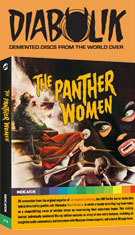
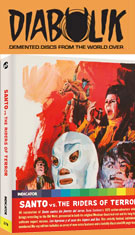
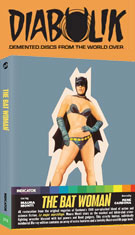
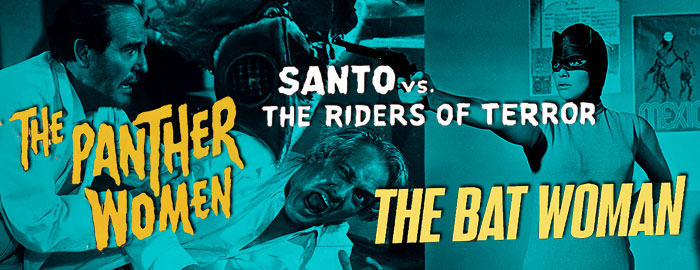
THE PANTHER WOMEN
B&W, 1967, 88 mins. 6 secs.
Directed by René Cardona
Starring Elizabeth Campbell, Ariadne Welter, Yolanda Montes, Eric del Castillo
Indicator (Blu-ray) (US/UK R0 HD), VCI (Blu-ray) (US R0 HD) / WS (1.66:1) (16:9)
THE BAT WOMAN
Color, 1968,
81 mins. 8 secs.
Directed by René Cardona
Starring
Maura Monti, Roberto Cañedo, Héctor Godoy, David SIlva, Armando Silvestre
Indicator (Blu-ray) (US/UK R0 HD), VCI (Blu-ray) (US R0 HD) / WS (1.66:1) (16:9)
SANTO VS. THE RIDERS OF TERROR
Color, 1970, 77 mins. 51 secs. / 84 mins. 30 secs.
Directed by René Cardona
Starring Santo,
Armando Silvestre, Julio Aldama, Mary Montiel
Indicator (Blu-ray) (US/UK R0 HD), VCI (DVD) (US R0 NTSC) / WS (1.66:1) (16:9)
Trying to pick a favorite 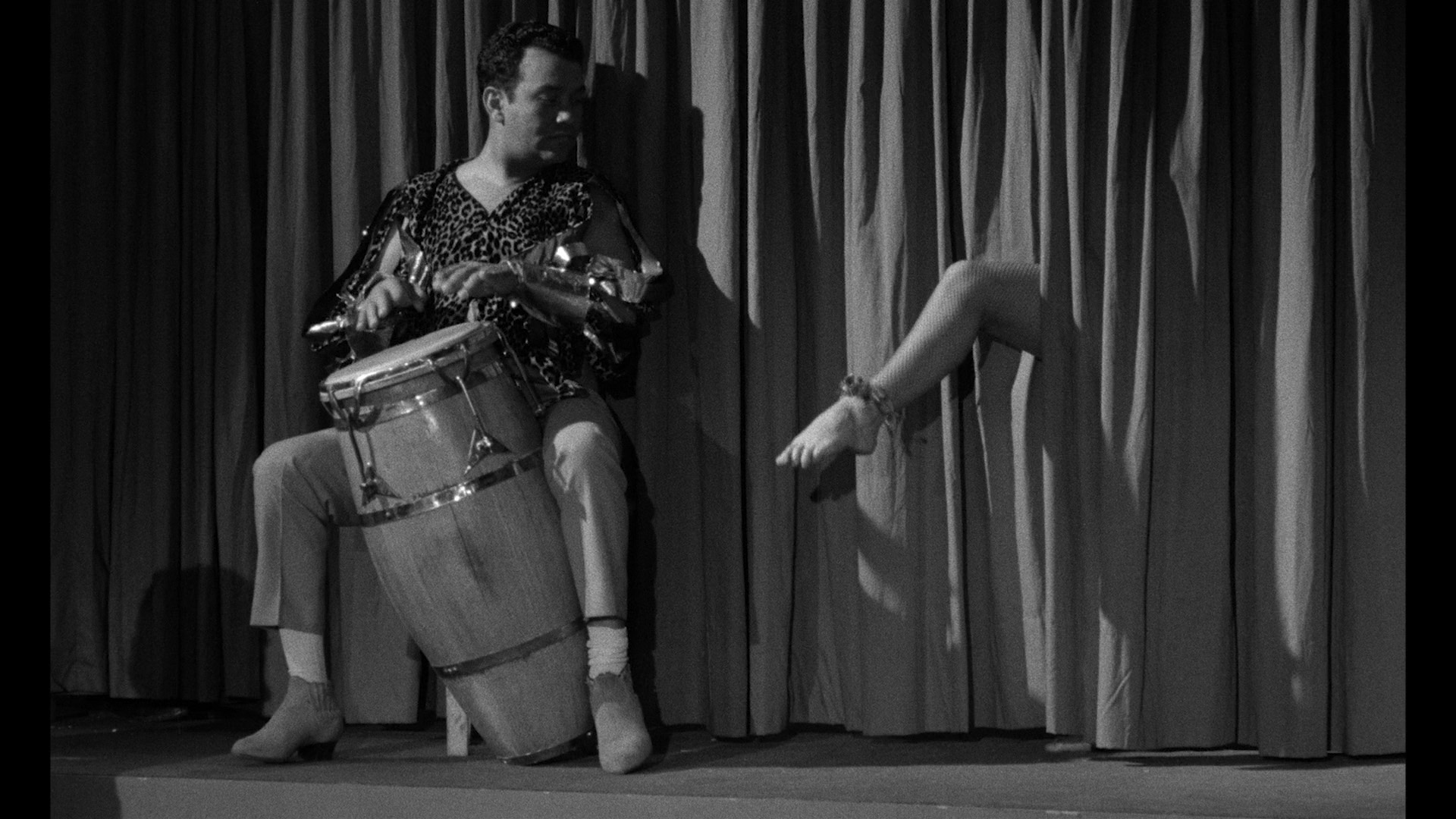 wrestling creature feature from the many entries in
wrestling creature feature from the many entries in 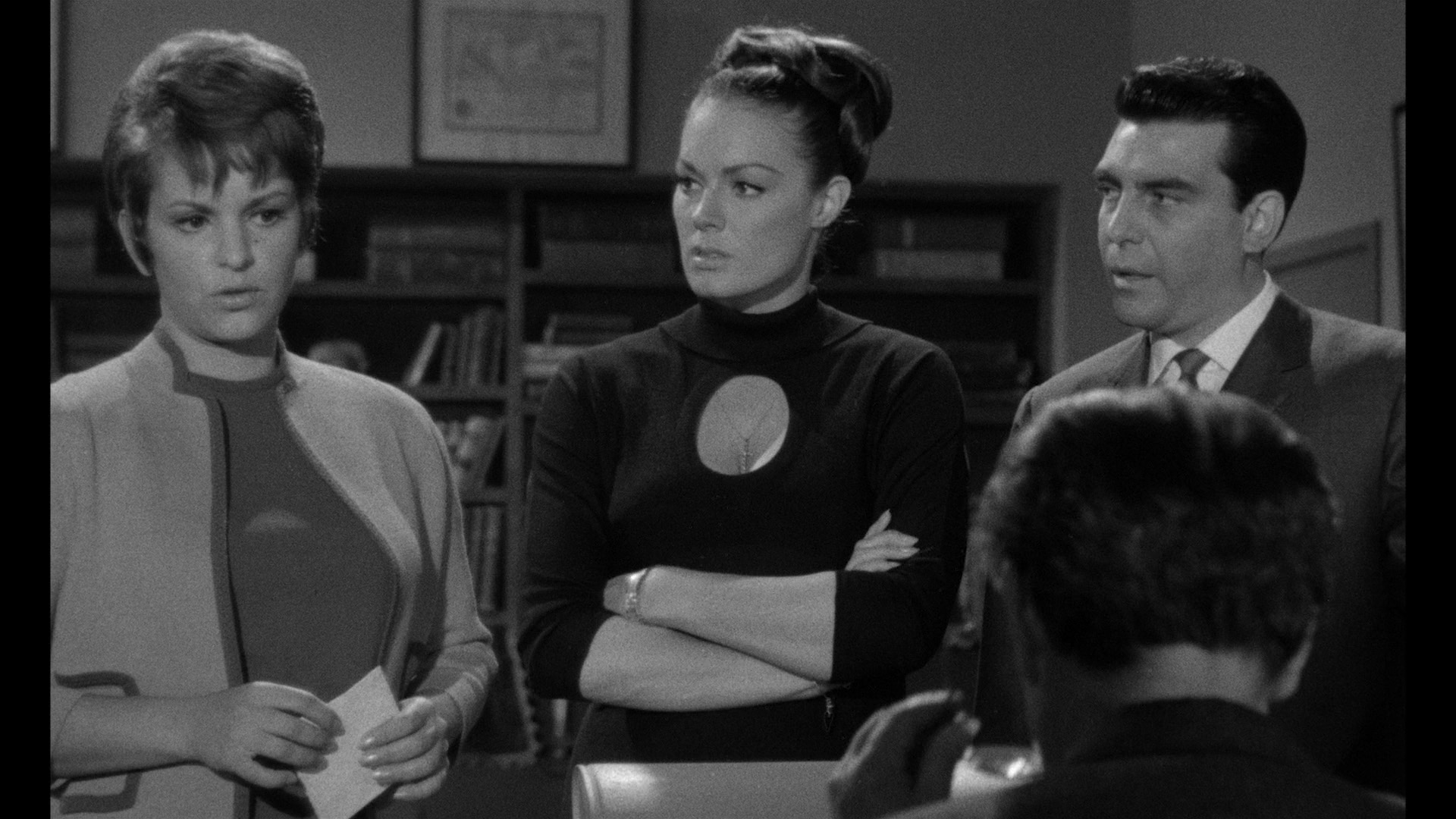 Mexican cinema is a daunting task, but Indicator has very busy with exceptional restorations of a few strong contenders. Case in point: three standalone Blu-ray editions in the U.S. and U.K. of wild offerings in the latter half of the '60s from the prolific René Cardona (Sr.), who warped plenty in minds around the world with Santa Claus, Night of the Bloody Apes, and Wrestling Women vs. the Aztec Mummy, among many others. Crime fighting, monsters, hideous diseases, and crazy outfits are all part of the mix here, now in sterling presentations that best earlier home video releases by a huge margin.
Mexican cinema is a daunting task, but Indicator has very busy with exceptional restorations of a few strong contenders. Case in point: three standalone Blu-ray editions in the U.S. and U.K. of wild offerings in the latter half of the '60s from the prolific René Cardona (Sr.), who warped plenty in minds around the world with Santa Claus, Night of the Bloody Apes, and Wrestling Women vs. the Aztec Mummy, among many others. Crime fighting, monsters, hideous diseases, and crazy outfits are all part of the mix here, now in sterling presentations that best earlier home video releases by a huge margin.
First up is 1967's The Panther Women (Las mujeres panteras), which unfolds in tried-and-true fashion with a montage of lady lucha libre photos over the main titles. Then we're off to a spooky cave where a black-clad panther cult is concocting a plan to revive its leader, Eloim, who was executed two centuries ago by druids led by Pietrasanta. Now the executioner's four descendants are being targeted for death before the next full moon while the 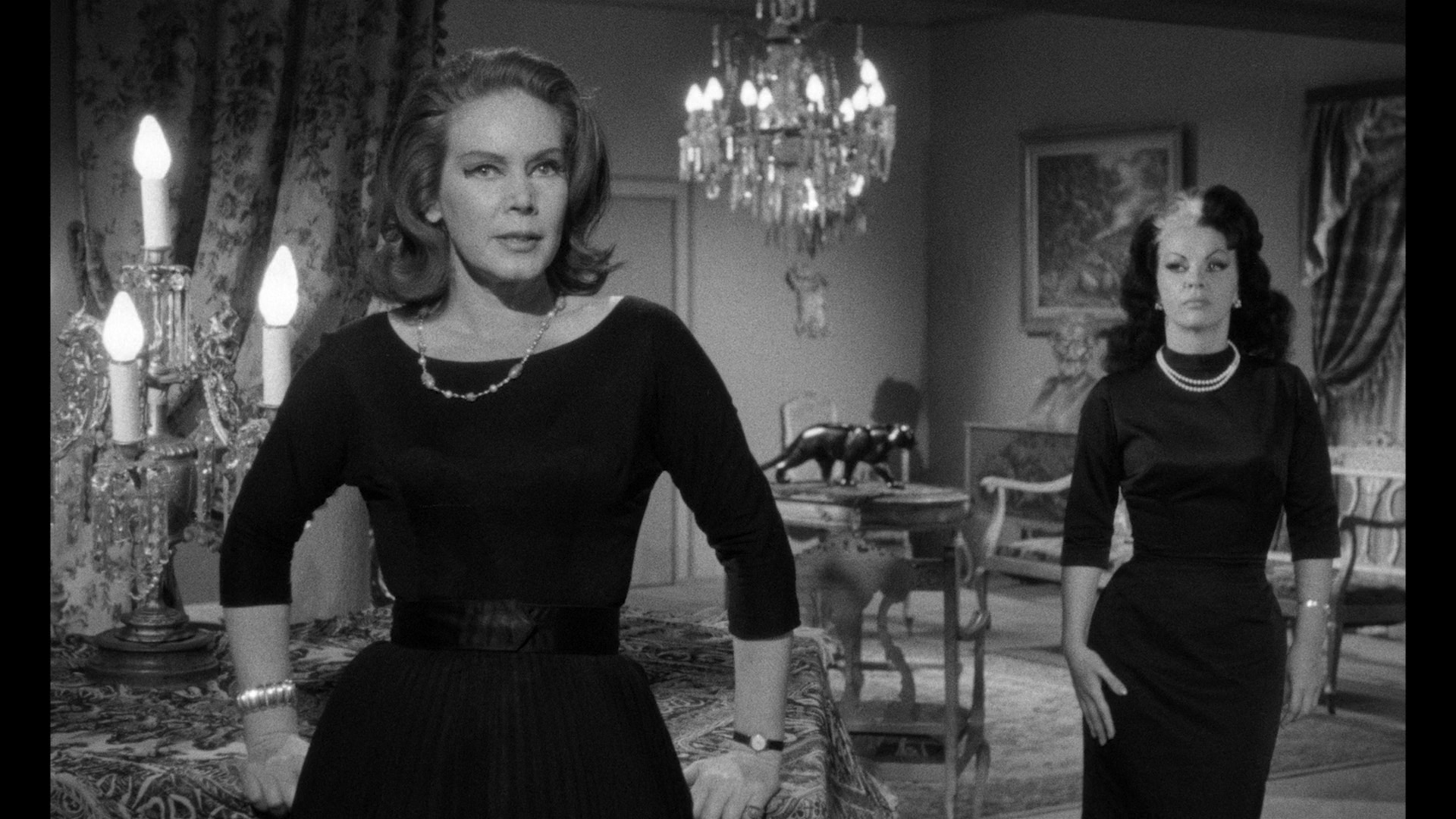 cultists carry out their insidious resurrection scheme involving panther people with fuzzy paws.
cultists carry out their insidious resurrection scheme involving panther people with fuzzy paws. 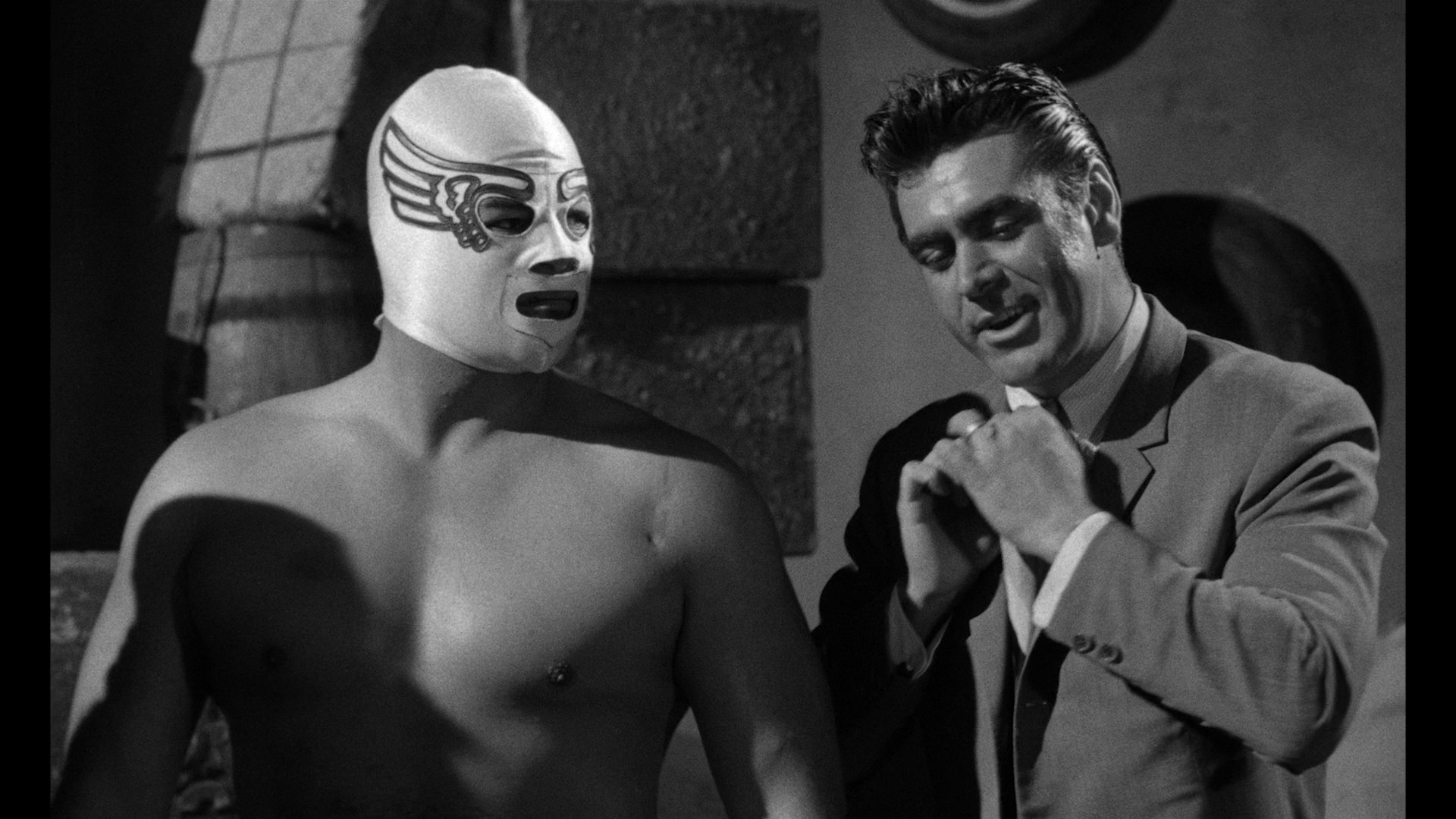 Enter two cheerful crime-fighting wrestlers, Loreta Venus (Welter) and Golden Rubí (Campbell), who are brought in when threatening letters from the Panthers of Eloim start popping up. Also on hand is a "totally not Santo" beefy masked wrestler, Angel, a criminologist chemist who lends a hand in stopping the murder spree.
Enter two cheerful crime-fighting wrestlers, Loreta Venus (Welter) and Golden Rubí (Campbell), who are brought in when threatening letters from the Panthers of Eloim start popping up. Also on hand is a "totally not Santo" beefy masked wrestler, Angel, a criminologist chemist who lends a hand in stopping the murder spree.
Quite atmospheric at times with its Cat People-style scenes of panther folks stalking through woods and city streets, The Panther Women is a bit more ambitious than usual for Cardona around this time and really should have been picked up for U.S. distribution back in the day. The screwy plot turns and can't-miss combination of wrestlers and monsters make for plenty of fun, and it's a solid entry in the line of black-and-white films in the lucha libre subgenre that was about to completely switch over to blazing color. In 2021, VCI finally brought the film to U.S. audiences as a Blu-ray double feature with The Bat Woman (more on that below), but it was a complete mess thanks to shoddy 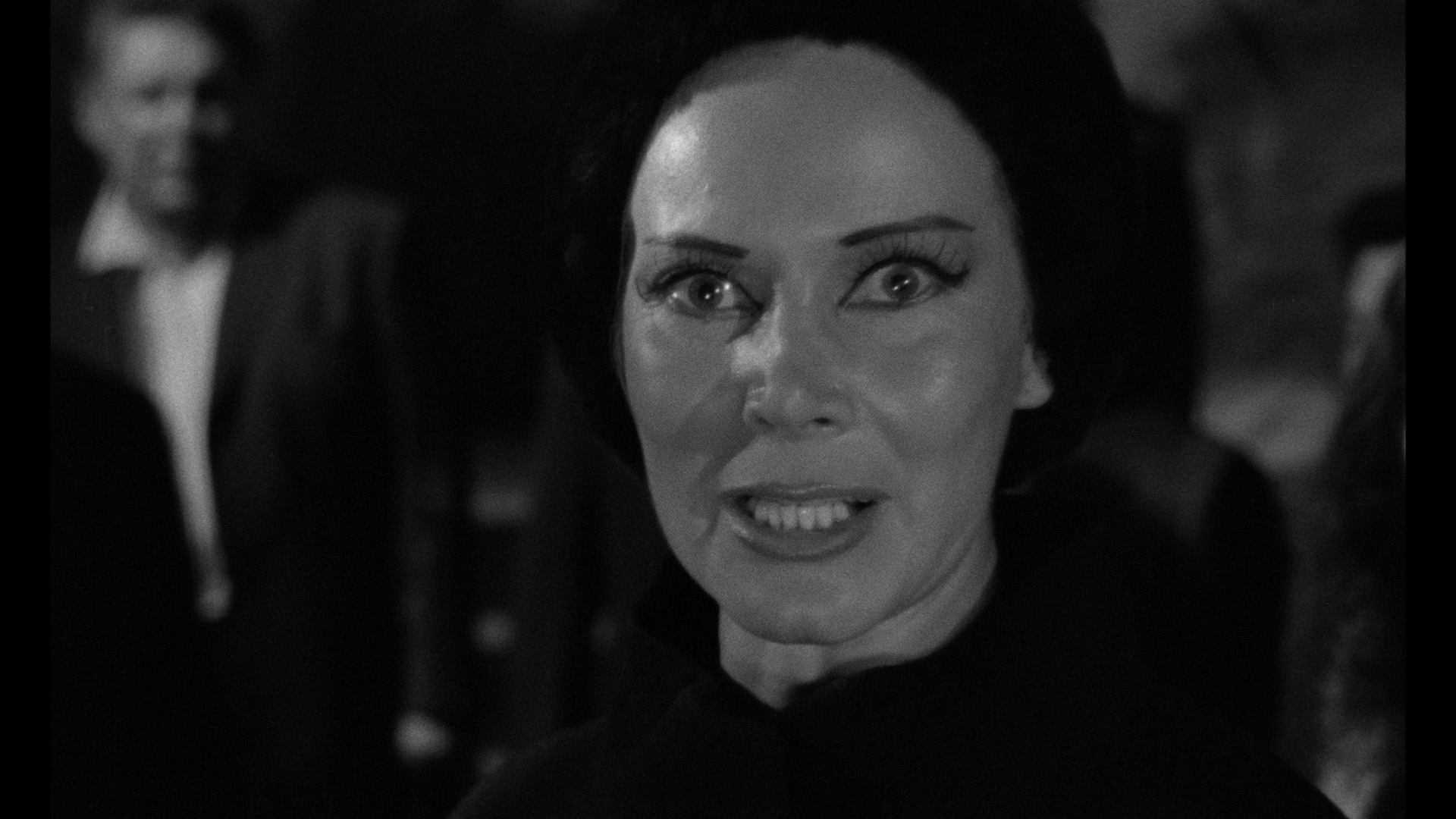 compression and the decision to present it only with a
compression and the decision to present it only with a 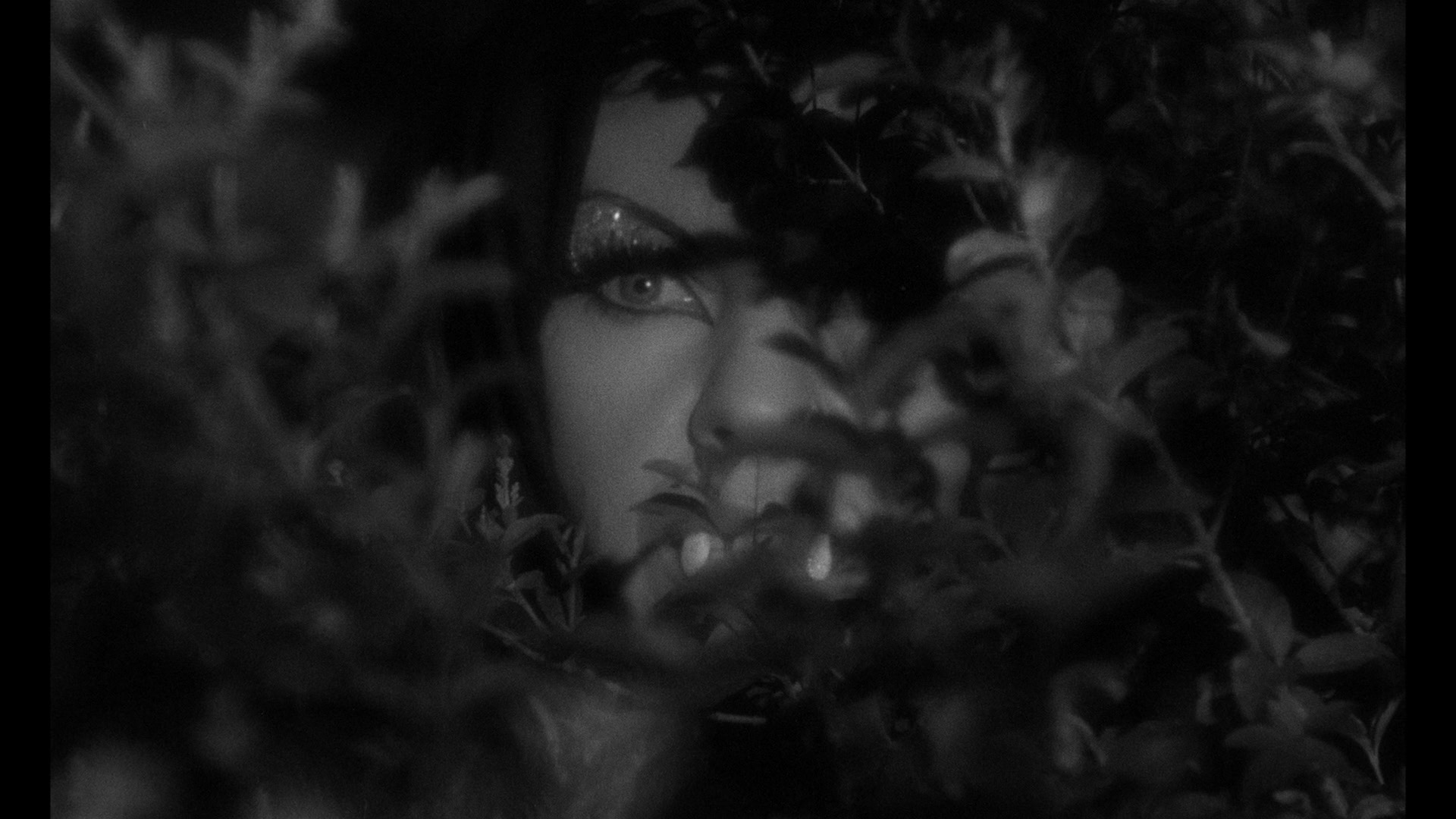 newly recorded English dub, featuring extremely subpar voice talent (to put it mildly).
newly recorded English dub, featuring extremely subpar voice talent (to put it mildly).
Far better is the Indicator Blu-ray from 2024, which looks and sounds fantastic with the 2K restoration from the negative really shining throughout. This time you get the original Spanish mono audio (1.0 LPCM) with optional English subtitles, and it's absolutely the way to go. A new audio commentary by Keith J. Rainville, From Parts Unknown publisher and screenwriter of Los campeones de la lucha libre, is entertaining and informative as he walks through the conventions of the lucha libre film (including the obligatory backstage info dump scene) and backgrounds on all the major players, including the wild story of skunk-haired scene stealer Tongolele a.k.a. Yolanda Montes. In "Let Them Fight!" (14m26s), "the masked critic" The Killer Film examines this film within the context of Cardona's output and the female wrestling history that informs some of the intentions and creative choices here. In "Cat Fight" (23m38s), academic and Latin American horror specialist Valeria Villegas Lindvall (a.k.a. Morena de Fuego) parses out this film as a representation of female strength, the feminine monster, and camaraderie within a fantastic framework. Also included are a subtitled theatrical trailer and a 44-image gallery, plus an 80-page booklet with an essay by Iain Robert Smith, archival essays by Janina Möbius and Ricardo Cárdenas Pérez, an interview with Guillermo Calderón, 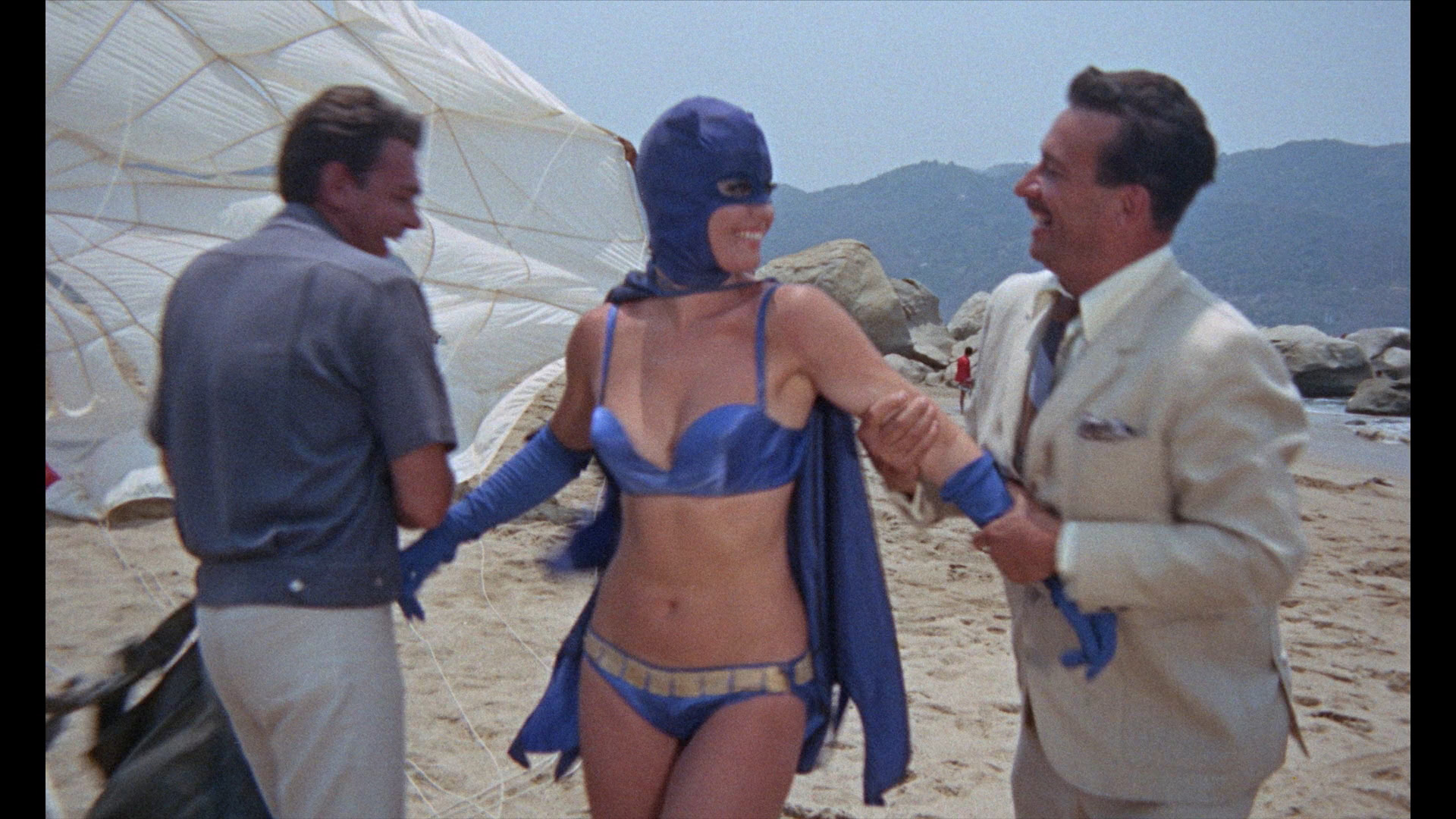
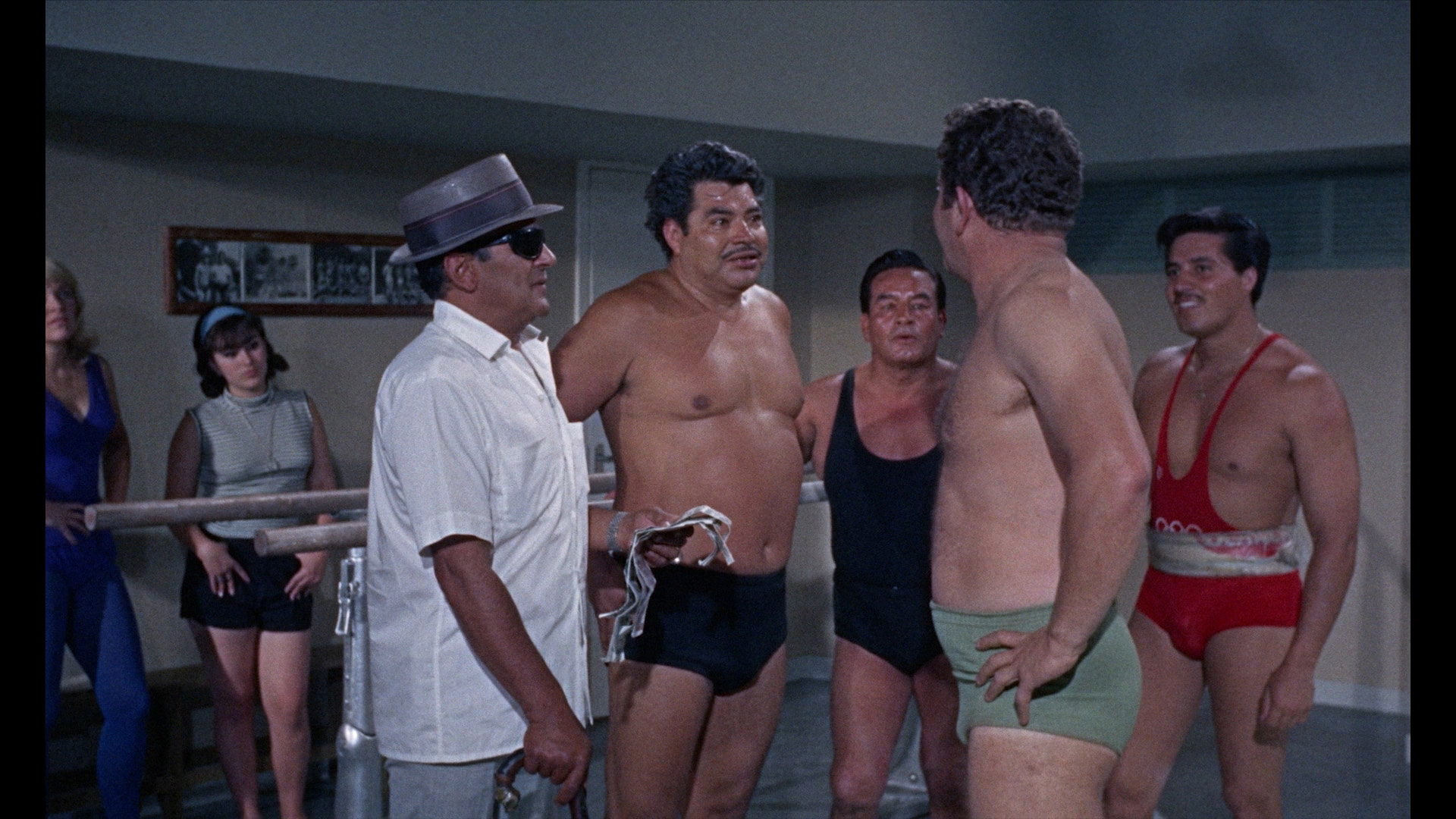 and film credits.
and film credits.
The following year's once-obscure The Bat Woman (La mujer murcielago) indeed switches to full color and heads to the sunny scenery of Acapulco, where five murder victims have recently washed up on the beach. All of the victims were wrestlers whose pineal glands had been removed (calling From Beyond!), so it's time to call in Gloria (Monti), "a wonderful, immensely wealthy woman who lives in the capital. She's using her fortune to serve justice, fighting tirelessly against evil. Thanks to her unique skills, she has mastered all types of sports." Oh, and she also puts on a bat mask and bikini to wrestle and fight crime, something you won't see Bruce Wayne doing. She manages to trace the misdeeds to a secret lab run by the scheming Dr. Williams (a marvelously hammy Cañedo), who's breeding fish guys underwater, but some well-timed acid only succeeds in escalating his plans.
The obvious inspiration here is the then-recent and popular Batman TV show, especially when it comes to our heroine's mask, 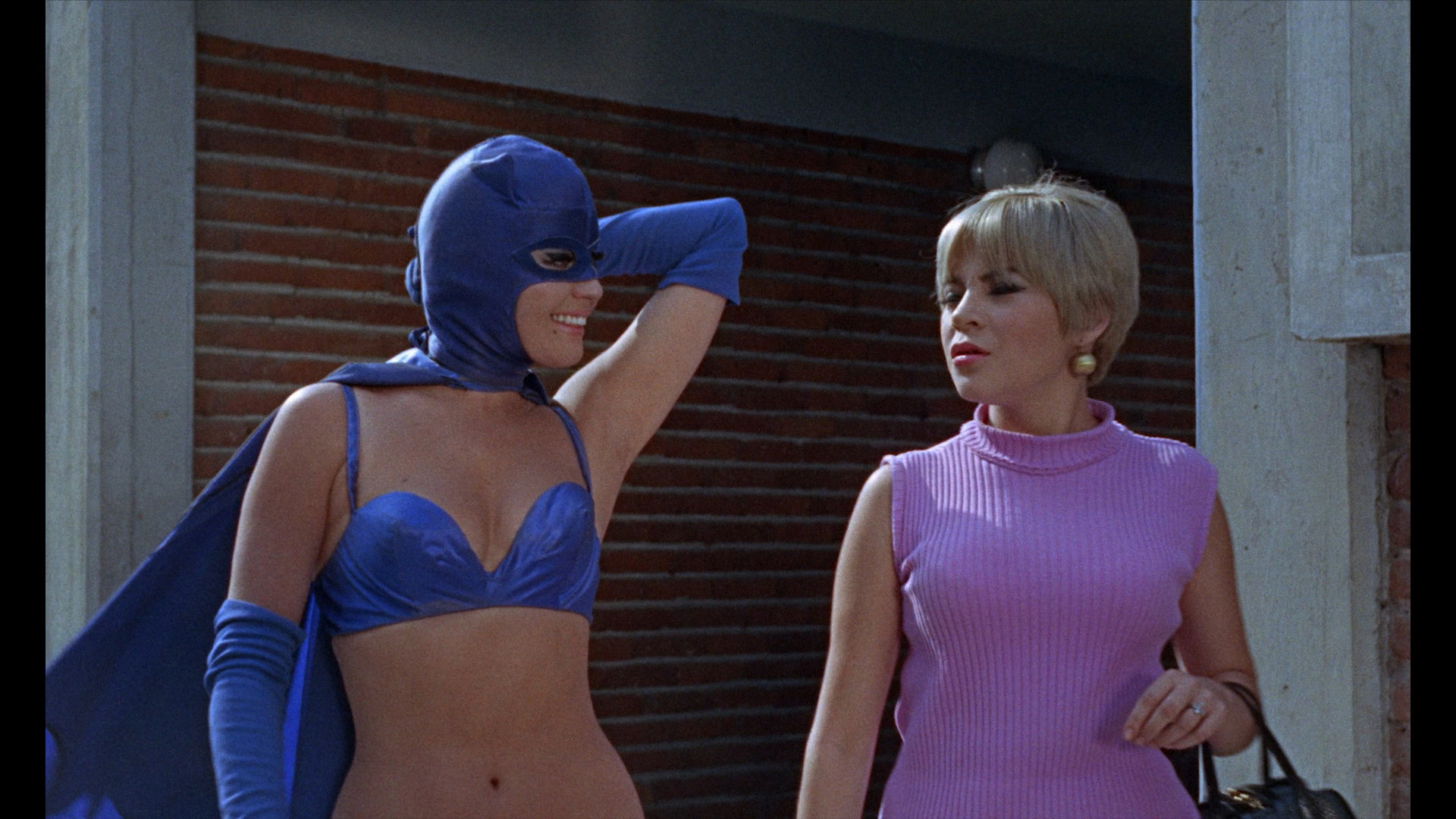 but
but 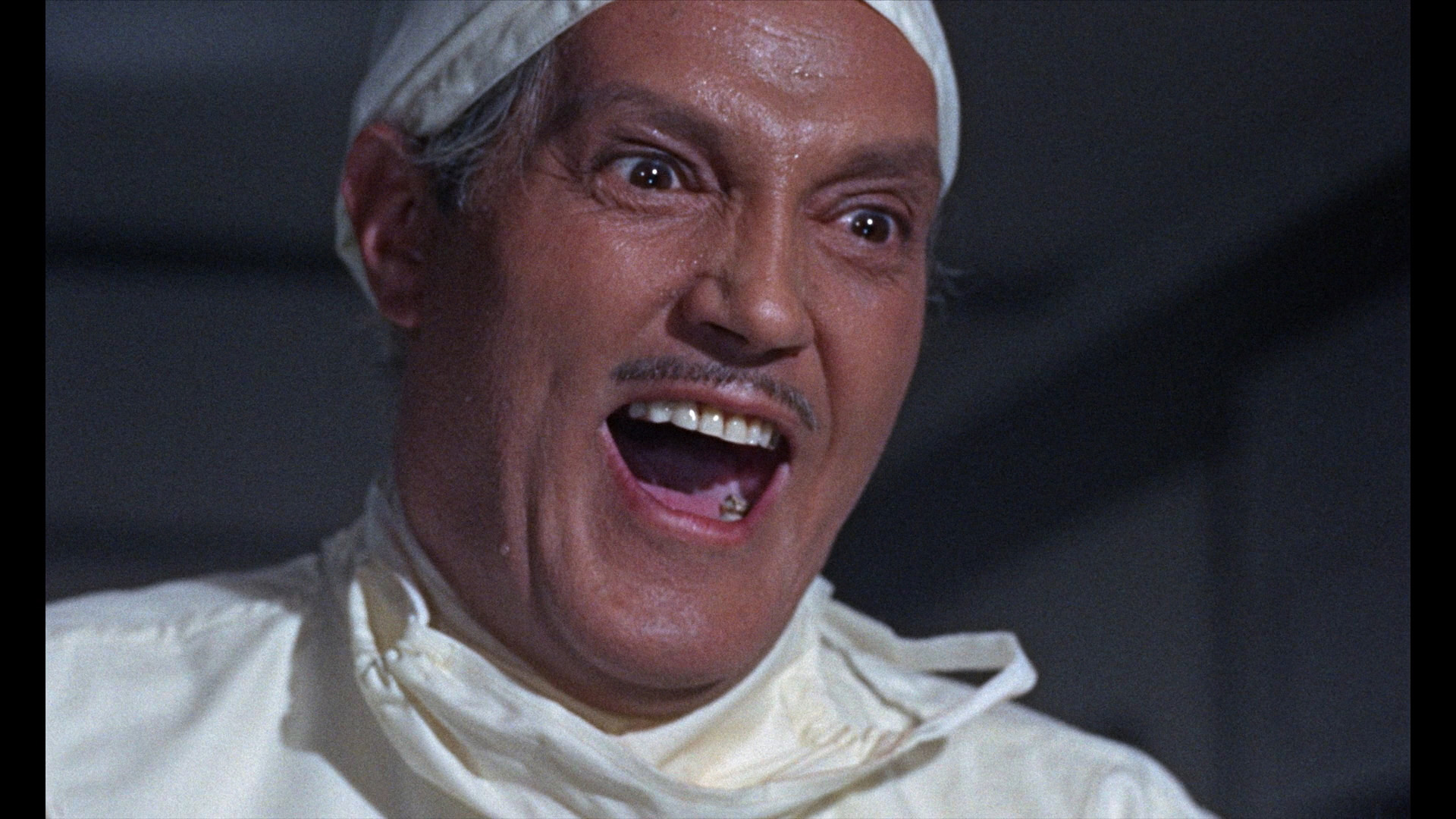 there's also plenty of novelty in the film's monster subplot (including a delightful creature costume) and its relaxed, sunny setting. Minti is the main attraction here, giving a genial performance that makes you root for her right off the bat. The wrestling element is almost an afterthought here, but there's so much else going on you won't even notice. This one did get a slight bit of play outside of Mexico (including Spanish-language theatrical venues in the U.S.) and got bootlegged from its Spanish-language VHS release a few times, and as mentioned above, it suffered the indignity of a terrible English dub for its Blu-ray bow from VCI.
there's also plenty of novelty in the film's monster subplot (including a delightful creature costume) and its relaxed, sunny setting. Minti is the main attraction here, giving a genial performance that makes you root for her right off the bat. The wrestling element is almost an afterthought here, but there's so much else going on you won't even notice. This one did get a slight bit of play outside of Mexico (including Spanish-language theatrical venues in the U.S.) and got bootlegged from its Spanish-language VHS release a few times, and as mentioned above, it suffered the indignity of a terrible English dub for its Blu-ray bow from VCI.
Featuring an immaculate 4K restoration from the negative, the 2024 Indicator Blu-ray makes for great party viewing with the right mindset and has plenty of those splashy colors Cardona would keep pushing to greater extremes on the way to Bloody Apes. Again you get a crisp 1.0 mono LPCM Spanish track with excellent English subtitles, and a new audio commentary by David Wilt is nicely organized and educational as he tours through the state of Mexican cinema around this time, the obvious comic book 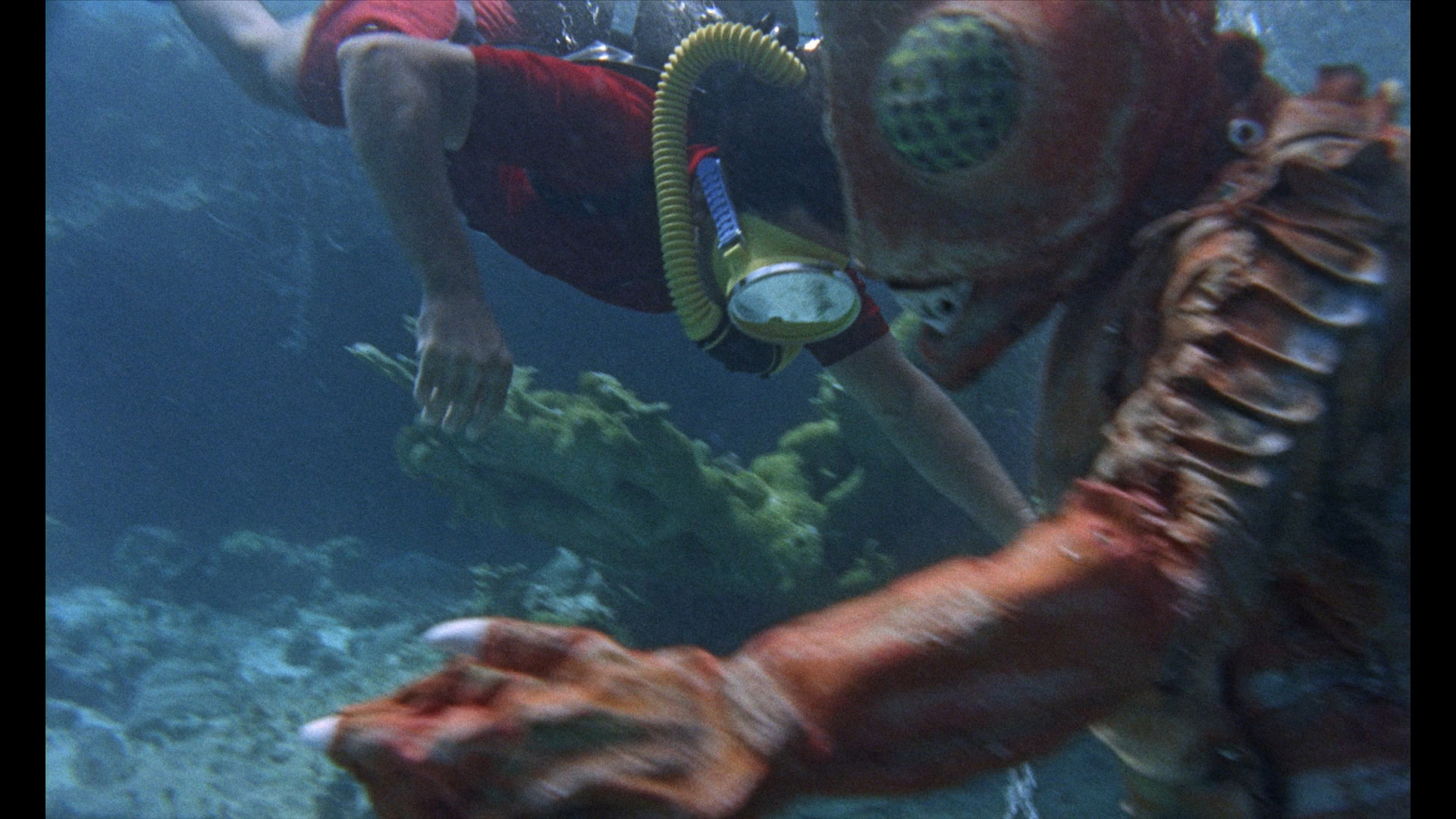 influence, the actors' backgrounds, and the film's release history and muted box office reception. In "Bat of
influence, the actors' backgrounds, and the film's release history and muted box office reception. In "Bat of 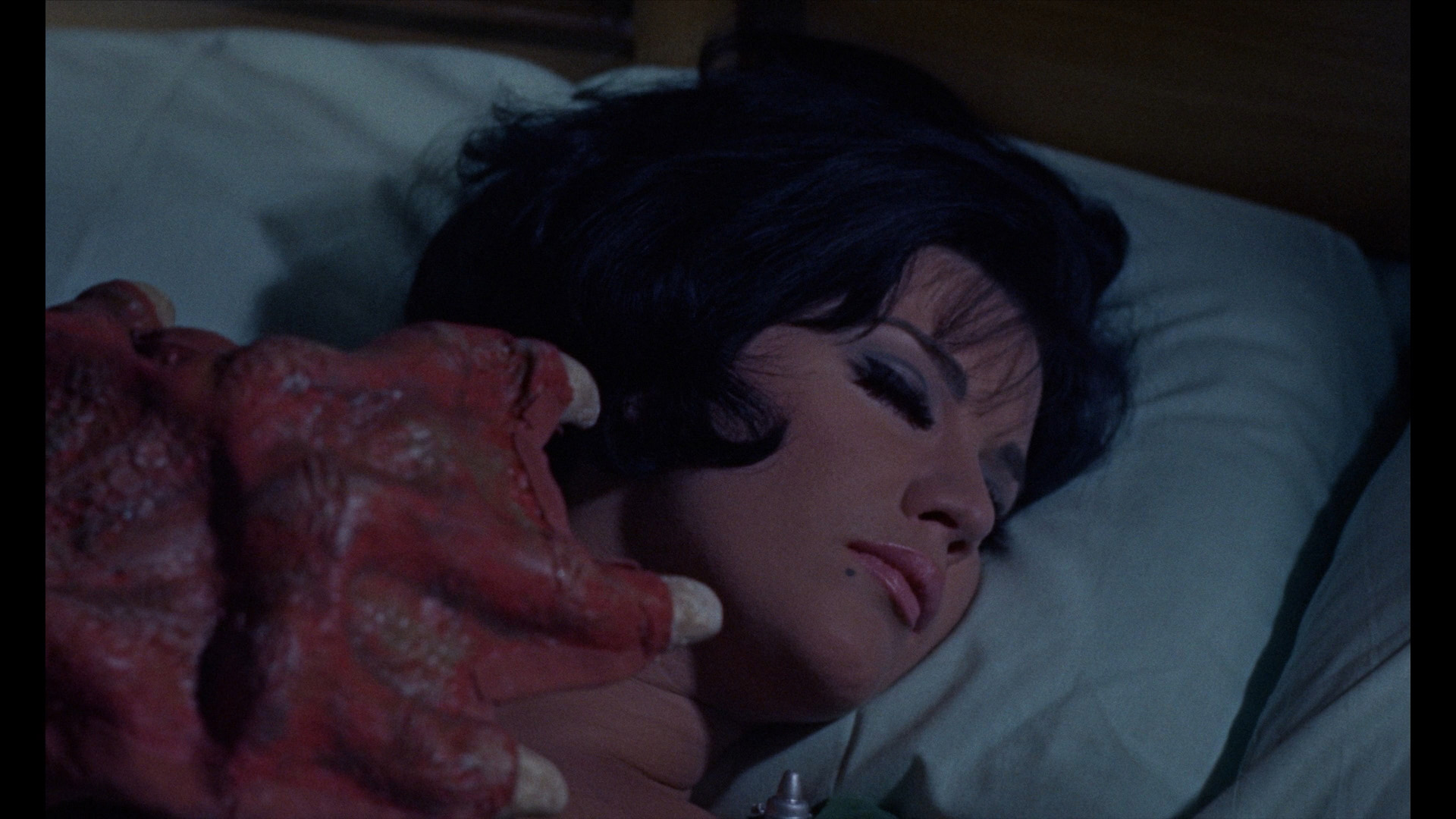 Nine Lives" (18m23s), Monti gives a great overview of her life and career including her early segue into modeling, her positive memories of Cardona, and the experiences of shooting Mexican productions including a great time working with Santo. "Adventures in Mexicolour" (20m20s) features Mauricio Matamoros Durán, journalist and editor of Belcebú, looking at the film from a sociological standpoint including the violent protest that occurred before the film hit theaters, the significance of some key poster art, the themes running through Santo films, shifting sexual politics, and other cultural aspects you could easily miss focusing on all the pulp fun on display. Finally in "Fantastique Creatures" (13m53s), film critic and Mostrología del cine mexicano author José Luis Ortega Torres gives an insightful overview of the film's intended audience and its expectations, the execution of the underwater and wrestling scenes, the necessity for an origin story of sorts, and the significance of restoring Mexican genre cinema in particular and its "unsung heroes." The subtitled Mexican trailer is also included along with an 84-image gallery, plus an 80-page insert book in the package with a new essay by Dolores Tierney, archival essays by Doyle Greene and Andrew Coe, archival
Nine Lives" (18m23s), Monti gives a great overview of her life and career including her early segue into modeling, her positive memories of Cardona, and the experiences of shooting Mexican productions including a great time working with Santo. "Adventures in Mexicolour" (20m20s) features Mauricio Matamoros Durán, journalist and editor of Belcebú, looking at the film from a sociological standpoint including the violent protest that occurred before the film hit theaters, the significance of some key poster art, the themes running through Santo films, shifting sexual politics, and other cultural aspects you could easily miss focusing on all the pulp fun on display. Finally in "Fantastique Creatures" (13m53s), film critic and Mostrología del cine mexicano author José Luis Ortega Torres gives an insightful overview of the film's intended audience and its expectations, the execution of the underwater and wrestling scenes, the necessity for an origin story of sorts, and the significance of restoring Mexican genre cinema in particular and its "unsung heroes." The subtitled Mexican trailer is also included along with an 84-image gallery, plus an 80-page insert book in the package with a new essay by Dolores Tierney, archival essays by Doyle Greene and Andrew Coe, archival 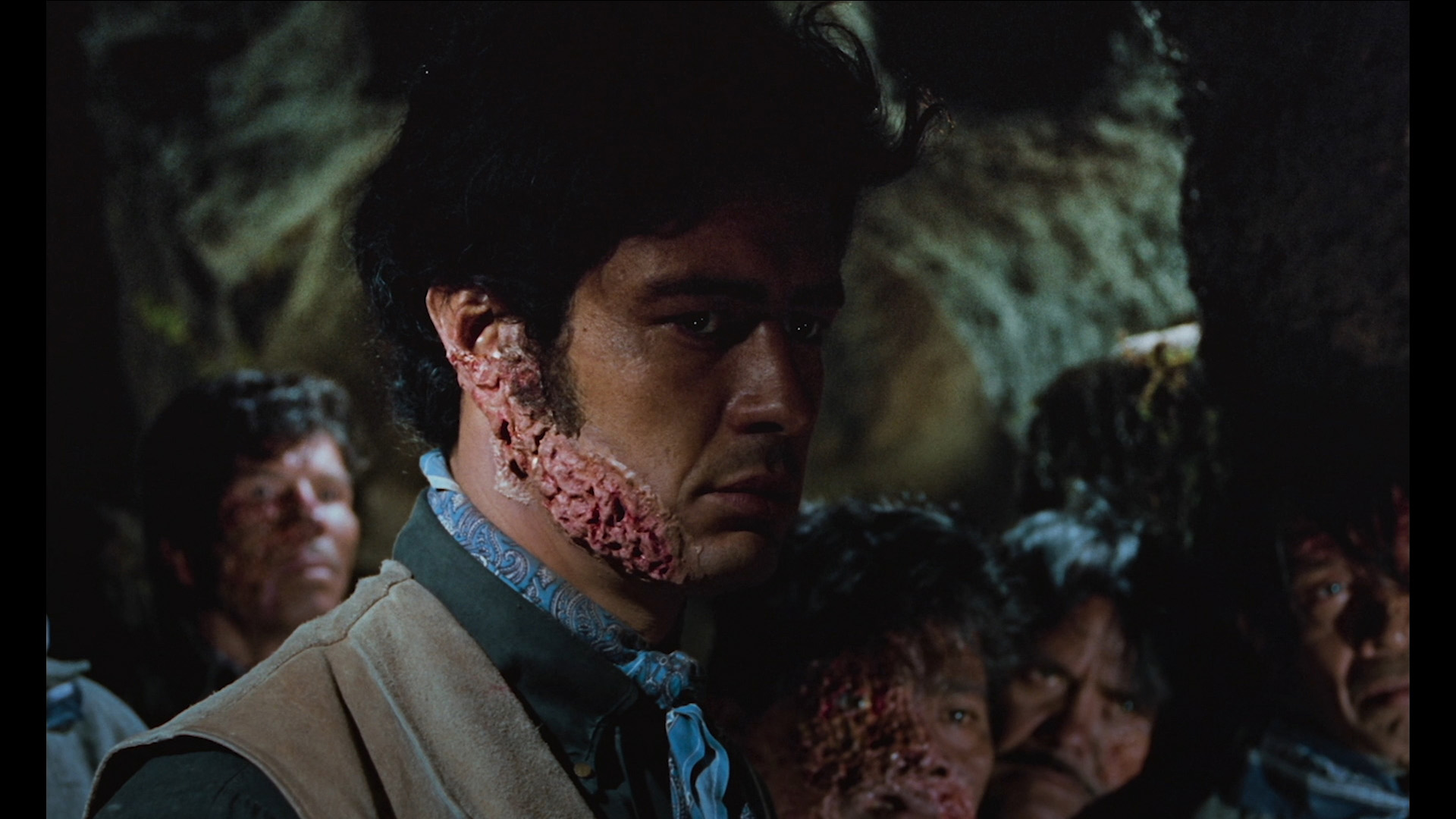 interviews with
interviews with 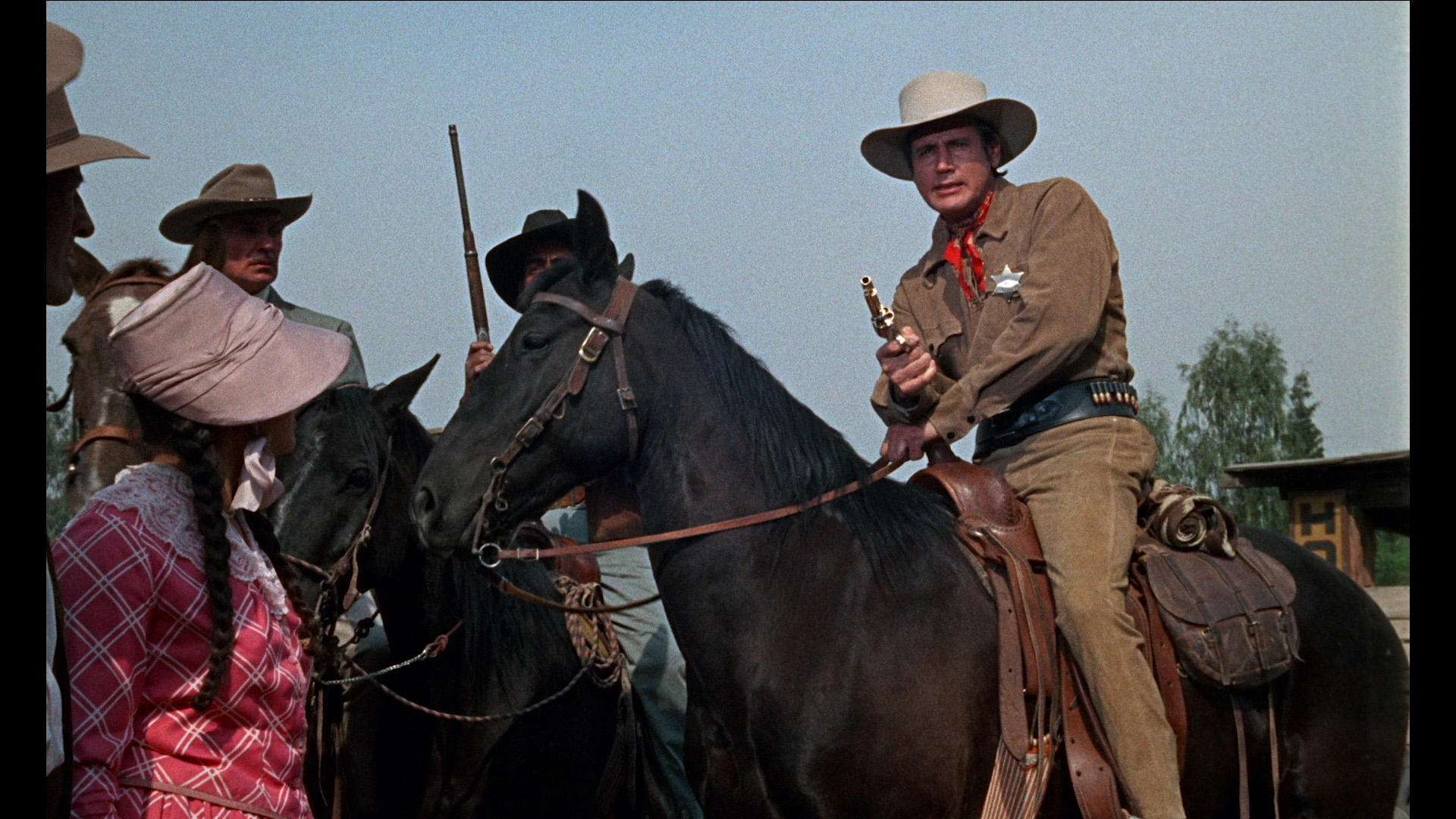 Monti, and film credits.
Monti, and film credits.
Finally we get more genre experimentation but with a very different slant in 1970's Santo vs. the Riders of Terror (Santo contra los jinetes del terror), a fusion of western and wrestling action with some grotesque window dressing that became the major selling point in its later reworking for the sexploitation market. Santo's only real western outing (and a period piece to boot), this one begins with a village sitting rather uncomfortably near a leper colony whose residents are just trying to live peacefully among themselves after getting out of a medical facility. Meanwhile everyone's favorite silver-masked wrestler is traveling and providing entertainment for locals, only to arrive in town just as some outlaw bandits are trying to take over the town and induce the lepers into becoming their lackeys. Encouraged by some nuns who are grateful to Santo for donating his earnings to orphans, our hero is enlisted to help 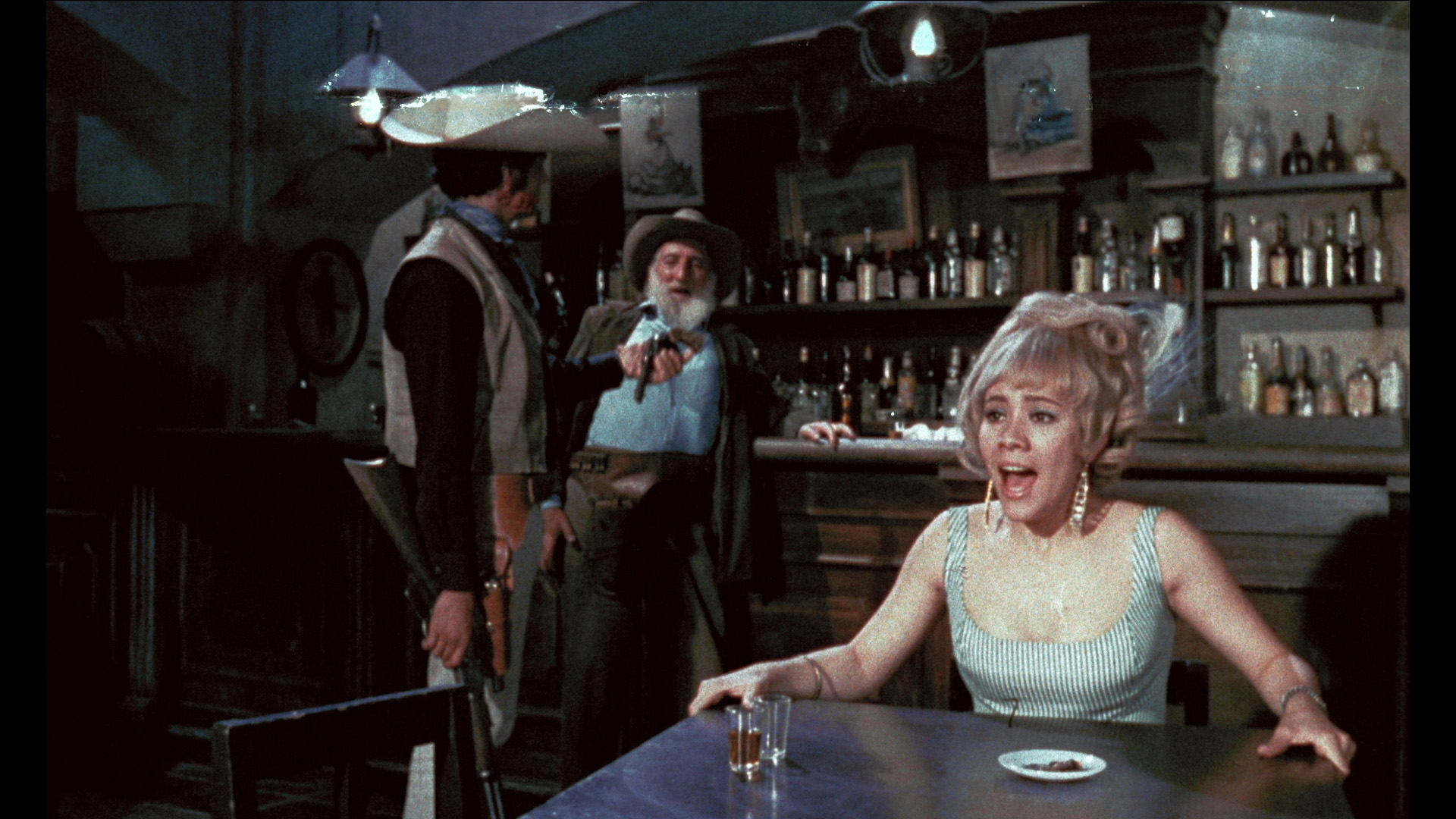 clean up the town and liberate the oppressed from these black-clad
clean up the town and liberate the oppressed from these black-clad 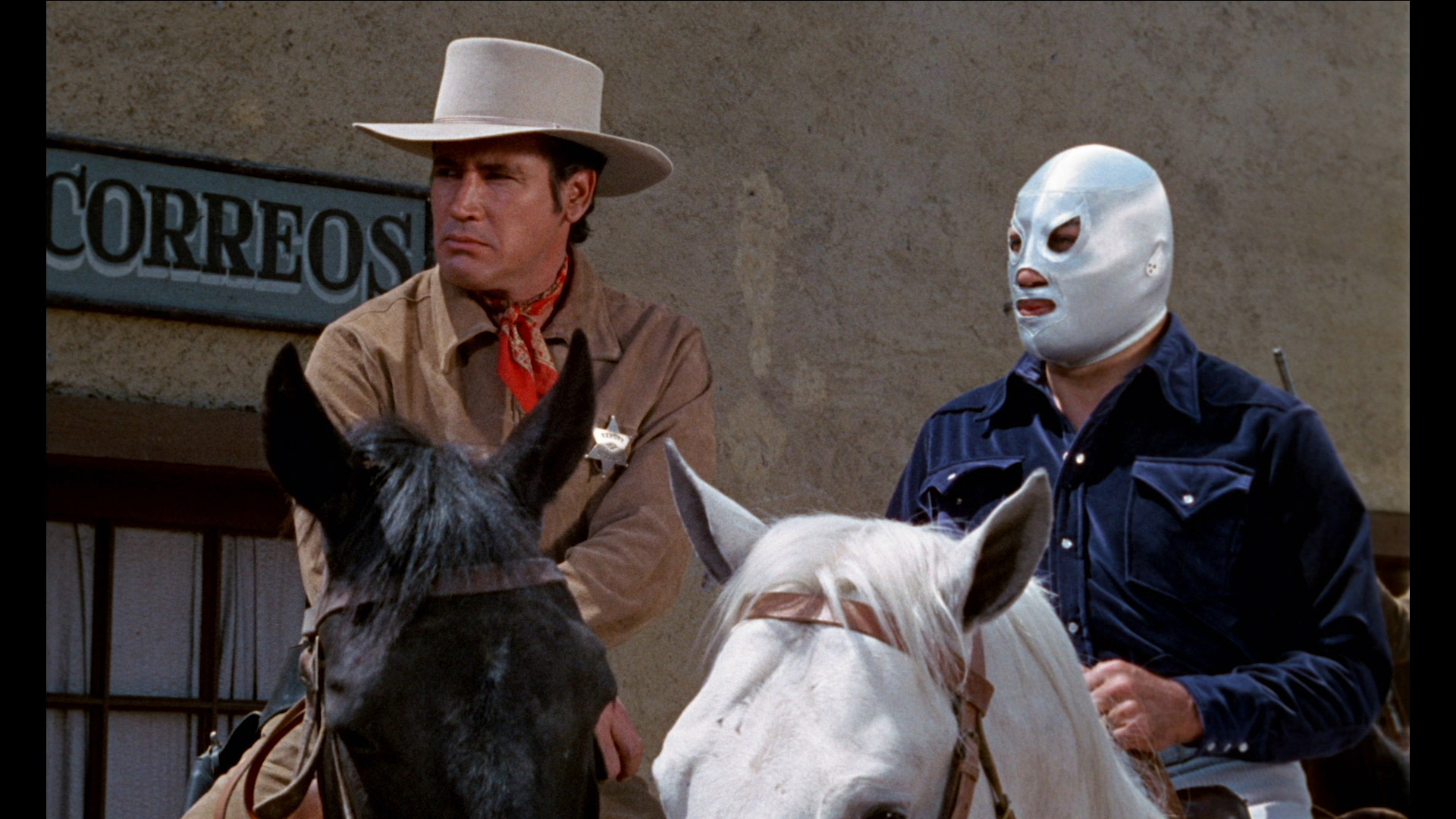 baddies.
baddies.
This one would be worthy of interest all by itself given the experience of seeing Santo essentially stepping into a scenario reminiscent of the many Sergio Leone imitations being cranked out at the time, here with the usual roster of Mexican character actors and that western atmosphere seen in local cinema for decades. However, as with a handful of other films (most famously Santo in The Treasure of Dracula), this was prepared in a spicier version for export use with 8 minutes of nude sex scenes added in. Incredibly, this version was entitled Los leprosos y el sexo, or Lepers and Sex, a title guaranteed to have audiences standing in line for hours just to get a peek. This alternate version, which features some fairly graphic softcore sex scenes including a visibly excited male actor in one shot, has been ignored entirely since the '70s (though it evidently played U.S. theaters in some form given the sexy stills floating around), but it's been revived here on the 2014 Blu-ray from Indicator along with the standard family-friendly version -- both in Spanish 1.0 LPCM mono with English subtitles. The film was previously issued by VCI on DVD in a disposable double feature with Santo in the Vengeance of the Mummy, but again this release is the way to go with the film 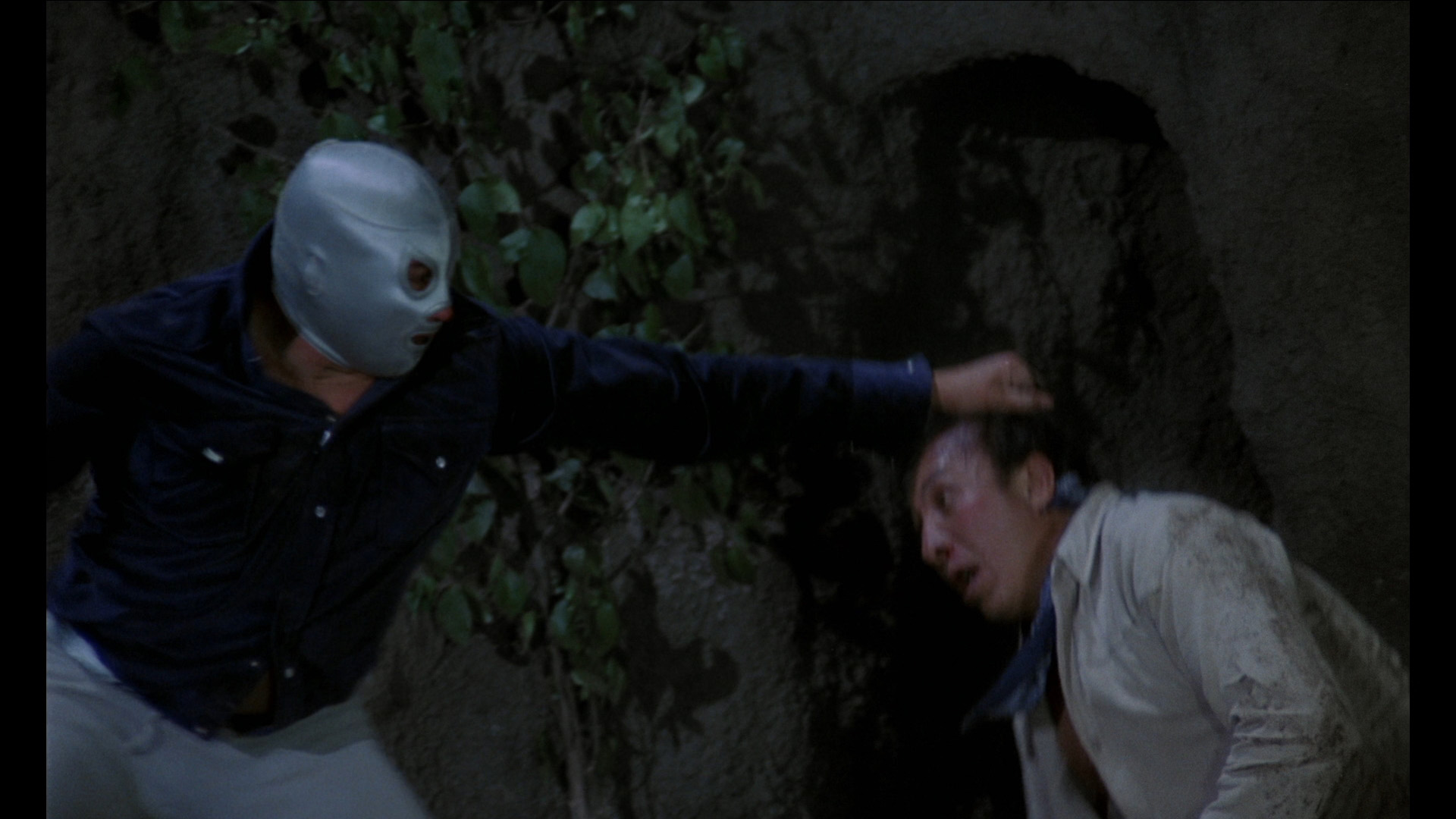 looking exceptionally good
looking exceptionally good 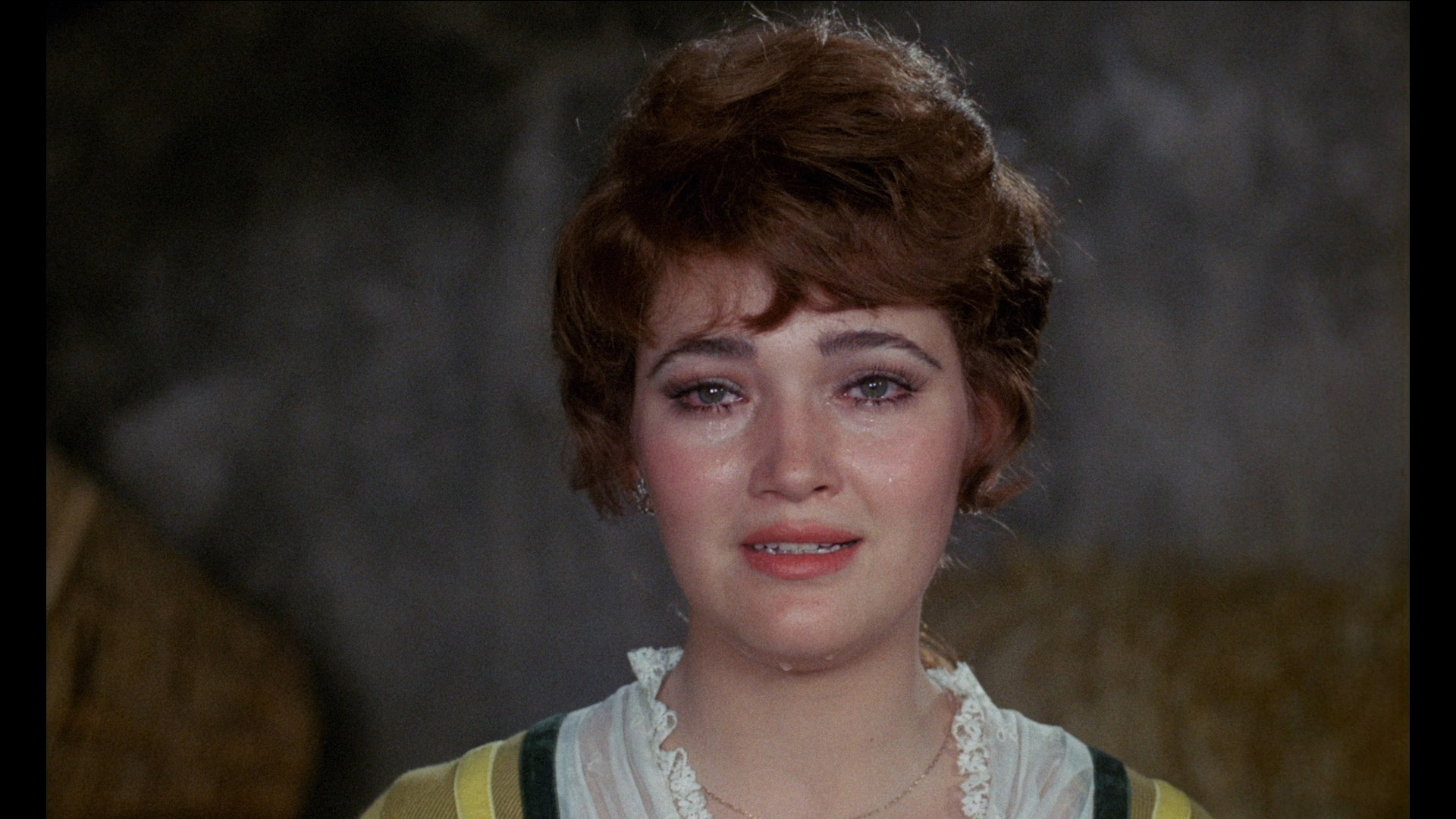 throughout. A new commentary by Wilt again (for the sexy cut) is another solid listen, pointing out notable actors in roles big and small and parsing out the film's weird release history and the qualities that set this apart from the flood of other Santo star vehicles.
throughout. A new commentary by Wilt again (for the sexy cut) is another solid listen, pointing out notable actors in roles big and small and parsing out the film's weird release history and the qualities that set this apart from the flood of other Santo star vehicles.
As for video extras, we kick off with "The New Sheriff in Town" (12m14s) with California-born actor actor Armando Silvestre talking about his childhood move to Mexico City, his involvement with producer Guillermo Calderón and his family, and highlights from his career in a variety of genres. The Killer Film shows up again for "Western a la Mexicana" (11m42s), which covers the history of masked wrestling and its ties to pop culture including moviemaking, the historical events that shook Mexico in the first half of the century, the wartime conflict that informed this film and some other productions, and the other notable aspects of this hybrid feature. In "Cardona Bonanza" (8m13s), writer and Trash-Mex website creator Armando Hernandez offers a handy overview of Cardona's career, the roles played in the industry by two future family generations, and the progression of the director's involvement in the industry going back to the 1930s. Also included are the alternate French titles (as Santo contre les cavaliers de la terreur), the subtitled Mexican trailer, and a 57-image gallery. The packaging also comes with the usual 80-page illustrated booklet, this time with a new essay by Colin Gunckel, archival essays by Doyle Greene, Olivia Cosentino and Brian Price, archival interviews with El Santo and Viviana García Besné, and film credits.
Reviewed on April 7, 2024.





 wrestling creature feature from the many entries in
wrestling creature feature from the many entries in  Mexican cinema is a daunting task, but Indicator has very busy with exceptional restorations of a few strong contenders. Case in point: three standalone Blu-ray editions in the U.S. and U.K. of wild offerings in the latter half of the '60s from the prolific René Cardona (Sr.), who warped plenty in minds around the world with Santa Claus, Night of the Bloody Apes, and Wrestling Women vs. the Aztec Mummy, among many others. Crime fighting, monsters, hideous diseases, and crazy outfits are all part of the mix here, now in sterling presentations that best earlier home video releases by a huge margin.
Mexican cinema is a daunting task, but Indicator has very busy with exceptional restorations of a few strong contenders. Case in point: three standalone Blu-ray editions in the U.S. and U.K. of wild offerings in the latter half of the '60s from the prolific René Cardona (Sr.), who warped plenty in minds around the world with Santa Claus, Night of the Bloody Apes, and Wrestling Women vs. the Aztec Mummy, among many others. Crime fighting, monsters, hideous diseases, and crazy outfits are all part of the mix here, now in sterling presentations that best earlier home video releases by a huge margin. cultists carry out their insidious resurrection scheme involving panther people with fuzzy paws.
cultists carry out their insidious resurrection scheme involving panther people with fuzzy paws.  Enter two cheerful crime-fighting wrestlers, Loreta Venus (Welter) and Golden Rubí (Campbell), who are brought in when threatening letters from the Panthers of Eloim start popping up. Also on hand is a "totally not Santo" beefy masked wrestler, Angel, a criminologist chemist who lends a hand in stopping the murder spree.
Enter two cheerful crime-fighting wrestlers, Loreta Venus (Welter) and Golden Rubí (Campbell), who are brought in when threatening letters from the Panthers of Eloim start popping up. Also on hand is a "totally not Santo" beefy masked wrestler, Angel, a criminologist chemist who lends a hand in stopping the murder spree. compression and the decision to present it only with a
compression and the decision to present it only with a  newly recorded English dub, featuring extremely subpar voice talent (to put it mildly).
newly recorded English dub, featuring extremely subpar voice talent (to put it mildly). 
 and film credits.
and film credits. but
but  there's also plenty of novelty in the film's monster subplot (including a delightful creature costume) and its relaxed, sunny setting. Minti is the main attraction here, giving a genial performance that makes you root for her right off the bat. The wrestling element is almost an afterthought here, but there's so much else going on you won't even notice. This one did get a slight bit of play outside of Mexico (including Spanish-language theatrical venues in the U.S.) and got bootlegged from its Spanish-language VHS release a few times, and as mentioned above, it suffered the indignity of a terrible English dub for its Blu-ray bow from VCI.
there's also plenty of novelty in the film's monster subplot (including a delightful creature costume) and its relaxed, sunny setting. Minti is the main attraction here, giving a genial performance that makes you root for her right off the bat. The wrestling element is almost an afterthought here, but there's so much else going on you won't even notice. This one did get a slight bit of play outside of Mexico (including Spanish-language theatrical venues in the U.S.) and got bootlegged from its Spanish-language VHS release a few times, and as mentioned above, it suffered the indignity of a terrible English dub for its Blu-ray bow from VCI.  influence, the actors' backgrounds, and the film's release history and muted box office reception. In "Bat of
influence, the actors' backgrounds, and the film's release history and muted box office reception. In "Bat of  Nine Lives" (18m23s), Monti gives a great overview of her life and career including her early segue into modeling, her positive memories of Cardona, and the experiences of shooting Mexican productions including a great time working with Santo. "Adventures in Mexicolour" (20m20s) features Mauricio Matamoros Durán, journalist and editor of Belcebú, looking at the film from a sociological standpoint including the violent protest that occurred before the film hit theaters, the significance of some key poster art, the themes running through Santo films, shifting sexual politics, and other cultural aspects you could easily miss focusing on all the pulp fun on display. Finally in "Fantastique Creatures" (13m53s), film critic and Mostrología del cine mexicano author José Luis Ortega Torres gives an insightful overview of the film's intended audience and its expectations, the execution of the underwater and wrestling scenes, the necessity for an origin story of sorts, and the significance of restoring Mexican genre cinema in particular and its "unsung heroes." The subtitled Mexican trailer is also included along with an 84-image gallery, plus an 80-page insert book in the package with a new essay by Dolores Tierney, archival essays by Doyle Greene and Andrew Coe, archival
Nine Lives" (18m23s), Monti gives a great overview of her life and career including her early segue into modeling, her positive memories of Cardona, and the experiences of shooting Mexican productions including a great time working with Santo. "Adventures in Mexicolour" (20m20s) features Mauricio Matamoros Durán, journalist and editor of Belcebú, looking at the film from a sociological standpoint including the violent protest that occurred before the film hit theaters, the significance of some key poster art, the themes running through Santo films, shifting sexual politics, and other cultural aspects you could easily miss focusing on all the pulp fun on display. Finally in "Fantastique Creatures" (13m53s), film critic and Mostrología del cine mexicano author José Luis Ortega Torres gives an insightful overview of the film's intended audience and its expectations, the execution of the underwater and wrestling scenes, the necessity for an origin story of sorts, and the significance of restoring Mexican genre cinema in particular and its "unsung heroes." The subtitled Mexican trailer is also included along with an 84-image gallery, plus an 80-page insert book in the package with a new essay by Dolores Tierney, archival essays by Doyle Greene and Andrew Coe, archival  interviews with
interviews with  Monti, and film credits.
Monti, and film credits. clean up the town and liberate the oppressed from these black-clad
clean up the town and liberate the oppressed from these black-clad  baddies.
baddies.  looking exceptionally good
looking exceptionally good  throughout. A new commentary by Wilt again (for the sexy cut) is another solid listen, pointing out notable actors in roles big and small and parsing out the film's weird release history and the qualities that set this apart from the flood of other Santo star vehicles.
throughout. A new commentary by Wilt again (for the sexy cut) is another solid listen, pointing out notable actors in roles big and small and parsing out the film's weird release history and the qualities that set this apart from the flood of other Santo star vehicles. ![]()